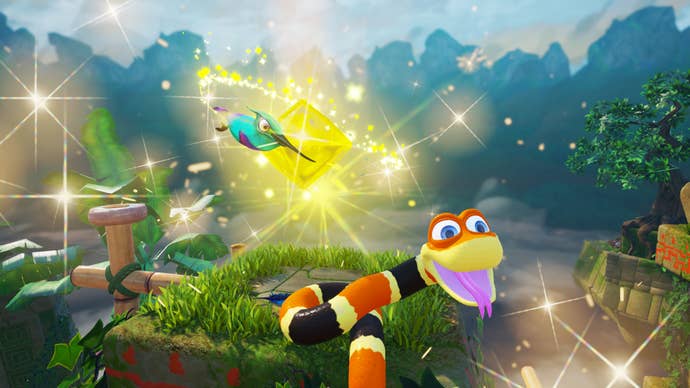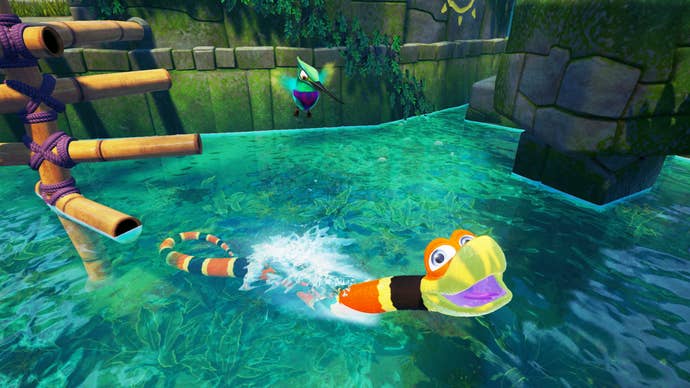Snake Pass Review
Sumo Digital tries something different with its newest title.
This article first appeared on USgamer, a partner publication of VG247. Some content, such as this article, has been migrated to VG247 for posterity after USgamer's closure - but it has not been edited or further vetted by the VG247 team.
You might look at Snake Pass and think, "Wow, that's a real cute snake." You look at the art style and assume that Snake Pass is a light, family friendly game. It feels like a throwback to the Nintendo 64 era of Rare. A puzzle platformer you can pick up easily and have a bit of fun.
Then Snake Pass goddamn blindsides you.
In Snake Pass, you play as Noodle, a snake seeking to save his hometown of Harmony Foothills. Together with his buddy Doodle the Hummingbird, you will slither and slide your way to the top of Havor Tor. In each level, you'll collect orbs, coins, and keystones in order to move forward.

Snake Pass takes being a snake very seriously. To move forward with any speed, you have to hold down the right trigger to slither and use the analog stick to slide side-to-side. To move upward, you have to do all that while holding your head up with the A button. Ascending to higher heights requires coiling yourself around bamboo platforms littered around each level, using a combination of slithering, raising your head, and using the left trigger to grip onto platforms tightly.
On top of all that, the player has to manipulate the camera. The camera can occasionally pick the wrong angle when you're slithering up a bamboo edifice. When you have to manually move the camera in tandem with everything above, Snake Pass can start to feel a bit tedious and annoying. Like you're fighting the game to proceed.

It's not easy and Snake Pass is one of those games that will weed out enthusiasts from casual players. It's a game that wants you to really feel what it's like to be a snake and you have to be willing to buy into the concept completely. That's not for everyone, but if you give it a chance and practice a bit, Snake Pass can end up being rather rewarding. At its heights, you'll pull off moves that look beautiful and graceful with ease. At its lows, you'll find yourself falling from a platform after spending 10-15 minutes winding your way forward.
It also doesn't help that Snake Pass' checkpoint system is a physical one. You can to touch glyphs to save your progress in a level. The issue is they tend to be spread out in each level. This means that after a difficult segment, you'll find yourself backtracking simply to save your progress before moving forward.
The pacing is also a bit off across the game's fifteen levels. The levels after the first four are where the difficulty feels like it spikes high, instead of being a gradual rise. The game will start to throw in new mechanics like switches, wind, and molten lava pits at you real quick, when you're just starting to get used to the controls. I recommend jumping back and really playing around in the first four levels; finding all the orbs and coins in those levels will prepare you for stuff Snake Pass throws at you immediately afterward.

On the other end, the levels don't feel like they match up to high-level play either. The gameplay is mostly the same across all fifteen levels. In addition, the difficulty isn't in figuring what you need to do in each level, as that's usually apparent. The hard part is in the execution and once you have that down, Snake Pass becomes an easier and more relaxing experience.
One area Snake Pass absolutely nails is its presentation. Each and every level is bright and colorful. Grass waves in the wind, lava glows beneath you, and there's a shimmer when you're swimming underwater. There's a bit of fuzz that pops up when playing the game in portable mode on the Switch, but otherwise, it's a generally beautiful game. This visual splendor is backed up by a great soundtrack by David Wise, who fans may recognize as the composer behind a number of Donkey Kong Country games.
I wanted to like Snake Pass more than I did. It's a beautiful game with a unique mechanic. If you're willing to give yourself over to the game, you'll find something that plays like nothing else on the market. At different points in the game, I jumped from frustrated tedium to elegant success. But through it all, at least I had the feeling that Sumo Digital was trying something new and that's worth supporting. If you're up for a mental challenge, pick up Snake Pass.
ConclusionVisually, Snake Pass recalls the Nintendo 64 era of Rare, with a bright and colorful presentation across its fifteen levels. When you dig into the game though, you find a unique set of controls that want to make the player really feel like a snake. If you spend time learning how Snake Pass controls, you'll find a rewarding, if sometimes uneven, experience.

